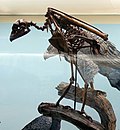Top Qs
Timeline
Chat
Perspective
List of Antillian and Bermudan animals extinct in the Holocene
From Wikipedia, the free encyclopedia
Remove ads
This is a list of Antillian and Bermudan animals extinct in the Holocene that covers extinctions from the Holocene epoch, a geologic epoch that began about 11,650 years before present (about 9700 BCE)[a] and continues to the present day.[1] This list includes the Antilles archipelago and the Bermuda Islands, collectively known as the West Indies.

The indigenous fauna of the West Indies collapsed in the Late Quaternary, with the rate of extinction for terrestrial mammals approaching 79-84%, one of the highest in the world. However, in stark contrast to the American continent, radiocarbon dating indicates that mammals survived the end of the Pleistocene with no apparent, or minimal losses despite localized sea level rise and climate change.[2] The same actually caused some bird extirpations and extinctions on the Bahamas, however.[3]
The indigenous peoples of the Caribbean arrived in the middle Holocene[4] and introduced guinea pigs, agoutis, and Native American dogs. While they accelerated the process, it was still not to the extent predicted by the "blitzkrieg" model of Pleistocene extinctions. For example, Caribbean sloths coexisted with humans for up to 400 years, even the largest species, which might indicate that they weren't commonly hunted. Some rodents, like the Puerto Rican hutia and Desmarest's hutia, and even flightless birds like the Antillean cave rail adapted well to human predation and were introduced to new islands by humans.[2][5] European colonization, beginning with the arrival of Christopher Columbus in 1492, brought in Old World rats, mice, domestic animals, and large-scale deforestation that eradicated many of the native animals and those introduced by indigenous peoples alike. The most recent extinctions happened after the late 19th century, following the introduction of the small Indian mongoose for rat control.[2]
Many extinction dates are unknown due to a lack of relevant information.
Remove ads
Mammals (class Mammalia)
Anteaters and sloths (order Pilosa)
Antillian sloths (family Megalocnidae)
Rodents (order Rodentia)
Neotropical spiny rats (family Echimyidae)
Possibly extinct
Giant hutias (family Heptaxodontidae)
Hamsters, voles, lemmings, muskrats, and New World rats and mice (family Cricetidae)
Primates (order Primates)
Titis, sakis, and uakaris (family Pitheciidae)
True insectivores (order Eulipotyphla)
West Indies shrews (family Nesophontidae)
Solenodons (family Solenodontidae)
Bats (order Chiroptera)
Mustached, ghost-faced, and naked-backed bats (family Mormoopidae)
Locally extinct
Leaf-nosed bats (family Phyllostomidae)
Locally extinct
Carnivorans (order Carnivora)
Earless seals (family Phocidae)
Remove ads
Birds (class Aves)
Nightjars (order Caprimulgiformes)
Typical nightjars (family Caprimulgidae)
Possibly extinct
Swifts, treeswifts, and hummingbirds (order Apodiformes)
Hummingbirds (family Trochillidae)
Pigeons and doves (order Columbiformes)
Pigeons and doves (family Columbidae)
Rails and cranes (order Gruiformes)
Rails (family Rallidae)
Cave rails (family Nesotrochidae)
Cranes (family Gruidae)
Locally extinct
Shorebirds (order Charadriiformes)
Thick-knees (family Burhinidae)
Locally extinct
Sandpipers (family Scolopacidae)
Possibly extinct
Albatrosses and petrels (order Procellariiformes)
Petrels and shearwaters (family Procellariidae)
Possibly extinct
Storks and allies (order Ciconiiformes)
Storks (family Ciconiidae)
Pelicans, herons, and ibises (order Pelecaniformes)
Ibises and spoonbills (family Threskiornithidae)
Herons (family Ardeidae)
Locally extinct
New World vultures (order Cathartiformes)
New World vultures and condors (family Cathartidae)
Teratorns (family Teratornithidae)
Hawks and relatives (order Accipitriformes)
Hawks, eagles, kites, harriers and Old World vultures (family Accipitridae)
Locally extinct
Owls (order Strigiformes)
True owls (family Strigidae)
Possibly extinct
Barn-owls (family Tytonidae)
Falcons (order Falconiformes)
Falcons and caracaras (family Falconidae)
Locally extinct
Woodpeckers and allies (order Piciformes)
Woodpeckers (family Picidae)
Possibly extinct
Parrots (order Psittaciformes)
Holotropical parrots (family Psittacidae)
Perching birds (order Passeriformes)
Chat-tanagers (family Calyptophilidae)
Possibly extinct
Crows and relatives (family Corvidae)
Locally extinct
Tanagers (family Thraupidae)
Possibly extinct
Swallows (family Hirundinidae)
Possibly extinct
New World blackbirds (family Icteridae)
New World sparrows (family Passerellidae)
Tapaculos (family Rhinocryptidae)
Wrens (family Troglodytidae)
Thrushes (family Turdidae)
Tyrant flycatchers (family Tyrannidae)
Locally extinct
New World warblers (family Parulidae)
Possibly extinct
Remove ads
Reptiles (class Reptilia)
Crocodilians (order Crocodilia)
Crocodiles (family Crocodylidae)
Locally extinct
Squamates (order Squamata)
Whiptails (family Teiidae)
Possibly extinct
Curly-tailed lizards (family Leiocephalidae)
Galliwasps (family Diploglossidae)
Possibly extinct
Iguanas and chuckwallas (family Iguanidae)
Anoles (family Dactyloidae)
Possibly extinct
Boas (family Boidae)
Colubrid snakes (family Colubridae)
Possibly extinct
Dwarf boas (family Tropidophiidae)
Possibly extinct
Turtles and tortoises (order Testudines)
Tortoises (family Testudinidae)
Remove ads
Amphibians (class Amphibia)
Frogs (order Anura)
Rain frogs (family Eleutherodactylidae)
Possibly extinct
Remove ads
Insects (class Insecta)
Butterflies (order Lepidoptera)
Swallowtail butterflies (family Papilionidae)
Family Uraniidae
Bark lice, book lice, and parasitic lice (order Psocodea)
Bird body lice (family Menoponidae)
Possibly extinct
Bird chewing lice (family Philopteridae)
Possibly extinct
Remove ads
Arachnids (class Arachnida)
Order Mesostigmata
Family Halarachnidae
Order Sarcoptiformes
Family Pteronyssidae
Scorpions (order Scorpiones)
Family Buthidae
Remove ads
Slugs and snails (class Gastropoda)
Family Neocyclotidae
Family Oleacinidae
Family Pleurodontidae
Remove ads
See also
Notes
- The source gives "11,700 calendar yr b2k (before CE 2000)". But "BP" means "before CE 1950". Therefore, the Holocene began 11,650 BP. Doing the math, that is c. 9700 BCE.
References
Wikiwand - on
Seamless Wikipedia browsing. On steroids.
Remove ads








































































